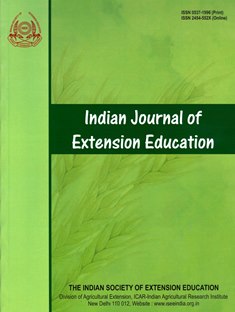Impact of Soil Health Card on Urea Fertilizer Usage and Crop Yield in Haryana
DOI:
https://doi.org/10.48165/IJEE.2025.61207Keywords:
Soil health, Urea usage, Crop yield, Economic analysis, HaryanaAbstract
Soil health is crucial for sustaining agricultural productivity. This study evaluates the impact of the Soil Health Card (SHC) scheme on fertilizer usage and crop yield in Haryana. Using primary data obtained from farm-level survey conducted utilizing a pre-tested semi structured schedule in 2024–25, the research compares urea application and crop productivity between SHC adopters and non-adopters. The impact of SHC adoption on urea usage and yield varies across crops. The findings indicate that while SHC-adopting farmers apply urea at levels below conventional practices, they still exceed recommended doses. SHC adoption leads to a statistically significant reduction in urea usage, without compromising crop yields. An economic analysis reveals that paddy and wheat farmers benefit from both cost savings and increased yield. The study underscores the potential of SHC in promoting balanced fertilizer usage while maintaining crop yield. The novel findings support the need for implementation of tailored nutrient management strategies to safeguard soil health.Downloads
References
Ai, H., Fan, B., & Zhou, Z. (2024). Hunger or illness? a trade-off on fertilizer use. Ecological Indicators, 166, 112432. https:// doi.org/10.1016/j.ecolind.2024.112432
Ankhila, R. H., Singh, A., Kumar, P., Kumar, S., Meena, M. C., Singh, R., & Sunil, B. H. (2023). Socio-economic impact of Soil Health Card scheme in the state of Andhra Pradesh. The Indian Journal of Agricultural Sciences, 93(6), 683-686. https://doi.org/ 10.56093/ijas.v93i6.134765
Aryal, J. P., Sapkota, T. B., Krupnik, T. J., Rahut, D. B., Jat, M. L., & Stirling, C. M. (2021). Factors affecting farmers’ use of organic and inorganic fertilizers in South Asia. Environmental Science and Pollution Research, 28(37), 51480–51496. https://doi.org/ 10.1007/s11356-021-13975-7
Chouhan, R. S., Sharma, H. O., Rathi, D., & Niranjan, H. K. (2017). Impact of soil health card scheme on farmers’ income–A case study of kharif crops in Madhya Pradesh. Agricultural Economics Research Review, 30(conf), 139-141. https://aercjbp.com/static/ media/RP-50.952a7d0b.pdf
Das, B. S., Wani, S. P., Benbi, D. K., Muddu, S., Bhattacharyya, T., Mandal, B., & Reddy, N. N. (2022). Soil health and its relationship with food security and human health to meet the sustainable development goals in India. Soil Security, 8, 100071. https://doi.org/10.1016/j.soisec.2022.100071
Grover, D. K., Singh, J. M., & Singh, J. (2016). Soil test-based fertilizer usage: a step towards sustainable agriculture in Punjab. Indian Journal of Economics and Development, 12(1a), 493-500. https:/ /doi.org/10.5958/2322-0430.2016.00112.8
Khanna, A., & Kaur, S. (2023). An empirical analysis on adoption of precision agricultural techniques among farmers of Punjab for efficient land administration. Land Use Policy, 126, 106533. https://doi.org/10.1016/j.landusepol.2022.106533
Mandal, A. K. (2024). Spatial assessment and chemical characterization of degraded (salt-affected) soils at post-reclamation stage of the Indo-Gangetic Plain in Haryana State. Environmental Monitoring and Assessment, 196(2), 213. https://doi.org/10.1007/s10661- 023-12197-3
Ohlan, R. (2021). Tajamul Haque (1947-2021). Economic and Political Weekly, 56(20), 5. https://www.epw.in/journal/2021/21/ commentary/farm-reforms-protests-and-election-haryana.html
Ohlan, R., Ohlan, A., & Singh, R. (2025). Adoption of soil health card by farmers in Haryana: Perceptions, challenges and way forward. Indian Journal of Extension Education, 61(1), 19-24. https://doi.org/10.48165/IJEE.2025.61104
Panda, S., Ghosh, A., Das, L., Modak, S., Mondal, S., Pal, P. K., & Nain, M. S. (2022). Economics of small tea farming system (STFS): an in-depth study of North Bengal, India. Indian Journal
of Extension Education, 58(1), 63-67. http://doi.org/10.48165/ IJEE.2022.58114
Patel, D. K., Kumar, A., & Dwivedi, S. (2023). Farmers’ challenges in adopting soil health card recommendations in Saharsa, Bihar. Indian Journal of Extension Education, 59(4), 154-156. https:/ /doi.org/10.48165/IJEE.2023.59431
Potapov, P., Turubanova, S., Hansen, M. C., Tyukavina, A., Zalles, V., Khan, A., & Cortez, J. (2022). Global maps of cropland extent and change show accelerated cropland expansion in the twenty-first century. Nature Food, 3(1), 19-28. https://doi.org/ 10.1038/s43016-021-00429-z
Reddy, K. S., Shivay, Y. S., Kumar, D., Pooniya, V., Prasanna, R., Mandi, S., & Borate, R. B. (2024). Relative performance of granulated and nano urea on productivity and nitrogen use efficiency of wheat–rice sequence. Plant Nano Biology, 100131. https://doi.org/10.1016/j.plana.2024.100131
Sahay, R., Singh, A. K., Singh, A., Maurya R. C., & Singh, S. (2019). Impact of soil health card in Unnao district of Uttar Pradesh. Indian Journal of Extension Education, 55(3), 101–103.https:/ /epubs.icar.org.in/index.php/IJEE/article/view/108288/42733
Shah, S. S., van Dam, J., Singh, A., Kumar, S., Kumar, S., Bundela, D. S., & Ritsema, C. (2025). Impact of irrigation, fertilizer, and pesticide management practices on groundwater and soil health in the rice–
wheat cropping system–a comparison of conventional, resource conservation technologies and conservation agriculture. Environmental Science and Pollution Research, 32(2), 533-558. https://doi.org/10.1007/s11356-024-35661-0
Sheoran, S., Prakash, D., Yadav, P. K., Gupta, R. K., Al-Ansari, N., El-Hendawy, S., & Mattar, M. A. (2024). Long-term application of FYM and fertilizer N improve soil fertility and enzyme activity in 51st wheat cycle under pearl millet-wheat. Scientific Reports, 14(1),21695. https://doi.org/10.1038/s41598-024- 72076-w
Singh, B. P., Kumar, V., Chander, M., Reddy, M. B., Singh, M., Suman, R. S., & Yadav, V. (2023). Impact of soil health card scheme on soil fertility and crop production among the adopted farmers. Indian Journal of Extension Education, 59(1), 122–126. http:/ /doi.org/10.48165/IJEE.2023.59125
Tripathi, S. C., Kumar, N., & Samota, S. R. (2023). Farmer’s fertilizer practices in wheat: A case study for high yield in north western plain zone. Indian Farming, 73(9), 37-39. https:// epubs.icar.org.in/index.php/IndFarm/article/view/138003
Zheng, S., Yin, K., & Yu, L. (2022). Factors influencing the farmer’s chemical fertilizer reduction behavior from the perspective of farmer differentiation. Heliyon, 8(12), e11918. https://doi.org/ 10.1016/j.heliyon.2022.e11918
Downloads
Published
Issue
Section
License

This work is licensed under a Creative Commons Attribution-NonCommercial-NoDerivatives 4.0 International License.

